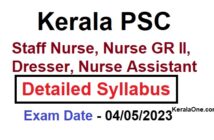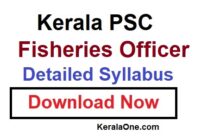Deprecated: Creation of dynamic property InsertPostAds::$settings is deprecated in /home4/keralaon/public_html/wp-content/plugins/insert-post-ads/insert-post-ads.php on line 427
Kerala PSC Head Of Section exam syllabus :Computer Engineer Detailed syllabus
Kerala PSC Head Of Section exam syllabus :Kerala Public Service Commission released Computer engineer Head of section exam date. Candidates who are applied for these posts can check detailed syllabus and prepare for your exam here.
Kerala PSC Head Of Section exam details
Name of the post:- Head Of Section – Computer engineer
Category number :- 253/2016
Exam date :- 22/05/2019 Wednesday Click here for more details
Kerala PSC Training Instructor Syllabus 2019 : Training Instructor (MMV) detailed syllabus
Kerala PSC Head Of Section exam syllabus
PART – I
General Knowledge, Current Affairs & Renaissance in Kerala
Salient Features of Indian Constitution – : Salient features of the Constitution – Preamble- Its significance and its place in the interpretation of the Constitution. Fundamental Rights – Directive Principles of State Policy – Relation between Fundamental Rights and Directive Principles – Fundamental Duties. Executive – Legislature – Judiciary – Both at Union and State Level. – Other Constitutional Authorities. Centre-State Relations – Legislative – Administrative and Financial. Services under the Union and the States. Emergency Provisions. Amendment Provisions of the Constitution.
Social Welfare Legislations and Programmes :- Social Service Legislations like Right to Information Act, Prevention of atrocities against Women & Children, Food Security Act, Environmental Acts etc. and Social Welfare Programmes like Employment Guarantee Programme, Organ and Blood Donation etc.
RENAISSANCE IN KERALA
Towards A New Society :– Introduction to English education – various missionary organisations and their functioning founding of educational institutions, factories.printing press etc.
Efforts To Reform The Society
(A) Socio-Religious reform Movements :- SNDP Yogam, Nair Service Society, Yogakshema Sabha, Sadhu Jana Paripalana Sangham, Vaala Samudaya Parishkarani Sabha, Samathwa Samajam, Islam Dharma Paripalana Sangham, Prathyaksha Raksha Daiva Sabha, Sahodara Prasthanam etc.
(B) Struggles and Social Revolts :- Upper cloth revolts.Channar agitation, Vaikom Sathyagraha, Guruvayoor Sathyagraha, Paliyam Sathyagraha. Kuttamkulam Sathyagraha, Temple Entry Proclamation, Temple Entry Act .Malyalee Memorial, Ezhava Memorial etc. Malabar riots, Civil Disobedience Movement, Abstention movement etc.
Role Of Press In Renaissance
Malayalee, Swadeshabhimani, Vivekodayam, Mithavadi, Swaraj, Malayala Manorama, Bhashaposhini, Mathnubhoomi, Kerala Kaumudi, Samadarsi, Kesari, AI-Ameen, Prabhatham, Yukthivadi, etc
Awakening Through Literature
Novel, Drama, Poetry, Purogamana Sahithya Prasthanam, Nataka Prashtanam, Library movement etc.
Women And Social Change
Parvathi Nenmenimangalam, Arya Pallam, A V Kuttimalu Amma, Lalitha Prabhu.Akkamma Cheriyan, Anna Chandi, Lalithambika Antharjanam and others
Leaders Of Renaissance
Thycaud Ayya Vaikundar, Sree Narayana Guru, Ayyan Kali.Chattampi Swamikal, Brahmananda Sivayogi, Vagbhadananda, Poikayil Yohannan(Kumara Guru) Dr Palpu, Palakkunnath Abraham Malpan, Mampuram Thangal, Sahodaran Ayyappan, Pandit K P Karuppan, Pampadi John Joseph, Mannathu Padmanabhan, V T Bhattathirippad, Vakkom Abdul Khadar Maulavi, Makthi Thangal, Blessed Elias Kuriakose Chaavra, Barrister G P Pillai, TK Madhavan, Moorkoth Kumaran, C. Krishnan, K P Kesava Menon, Dr.Ayyathan Gopalan, C V Kunjuraman, Kuroor Neelakantan Namboothiripad, Velukkutty Arayan, K P Vellon, P K Chathan Master, K Kelappan, P. Krishna Pillai, A K Gopalan, T R Krishnaswami Iyer, C Kesavan. Swami Ananda Theerthan , M C Joseph, Kuttippuzha Krishnapillai and others
Literary Figures
Kodungallur Kunhikkuttan Thampuran, KeralaVarma Valiyakoyi Thampuran, Kandathil Varghese Mappila. Kumaran Asan, Vallathol Narayana Menon, Ulloor S Parameswara Iyer, G Sankara Kurup, Changampuzha Krishna Pillai, Chandu Menon, Vaikom Muhammad Basheer. Kesav Dev, Thakazhi Sivasankara Pillai, Ponkunnam Varky, S K Pottakkad and others
PART – II
Data Communication: Components, LAN / MAN / WAN, Topologies, Analog, Digital Communication, ISO-OSI Architecture, TCP/IP, Transmission impairments, Media – Guided and unguided, Encoding techniques, Modulation, Error detection and correction, ARQ techniques, Multiplexing, FDM-TDM-WDM, Wireless communication, Switching techniques, Polling.
Computer Networks: Data Link Layer – MAC Sublayer, CSMA, CSMA/CD, Ethernet, IEEE Standards, LLC, ATM, Network layer – Routing algorithms, Congestion control algorithms, IPV4 and IPV6, Subnetting, Transport Layer – Services, Service primitives, Addressing, Application Layer – DNS, E-mail architecture, SMTP, POP3, MIME, Network Management Devices – Repeater, Hub, Switch, Router, Gateway, Wireless access point, UDP, HTTP, FTP, TELNET, VOIP
Information Security: Computer Security, CIA triad, OSI Security Architecture, X.800, Cryptography, Symmetric and asymmetric encryption, MAC, Hash function, Digital signature, User authentication – Token based, Biometric, Remote user authentication, Intrusion Detection Systems, Honey pots, Denial of Service, Firewall
Mobile Computing: Cellular systems, SDMA, FDMA, TDMA, CDMA, GSM, GEO, MEO, LEO, WLAN protocols, Bluetooth, WAP, VPN
Digital Computer Principles: Number systems – Binary, Decimal, Octal and Hexadecimal Conversion, Arithmetic operations, Boolean algebra, Logic gates, SOP, POS, Minterm and maxterms, Boolean expression, simplification, Postulates and theorems, Simplifications, K-Map, Combinational logic circuits – Adder, Subtractor, Multiplexer, Demultiplexer, Encoder, Decoder, Sequential Circuits – SR, JK, T, D flip flops, Shift registers, Asynchronous, synchronous and Modulo n Counters.
Microprocessors: Architecture of 8086, Registers, Addressing modes, Isolated and memory mapped I/O, Instruction set of 8086, Programming, Interrupt mechanism, 8255 PPI, 8257 DMA, 8279 Keyboard/Display interface, CISC, RISC processors, Hyper threading.
Computer Architecture: Multiprocessors and microcomputers, Assembly language, Assembler directives, Semiconductor memory – Internal organization, SRAM, DRAM, SDRAM, Rambus memory, ROM technology, Cache memory, virtual memory, working of magnetic disks and tapes, optical disks, Instruction sequencing, Instruction execution, Hardwired control and microprogrammed control, micro instructions, Pipelining.
Operating Systems: Batch, microprogramming, time sharing, multi processor and real time systems, Process management, Process Control Block, Threading, multi-threading, CPU Scheduling, Schedulers, Context switching, Pre-emptive and non-preemptive scheduling, Scheduling algorithms – FCFS, SJF, Priority, RR, Multi-level and multilevel feed back queue, Race condition, Critical section problem, Deadlock – detection and prevention, Memory Management – Address bindings, logical and physical addresses, contiguous memory allocation – first fit, best fit, worst fit allocation, internal and external fragmentation, Paging and segmentation, Demand paging, Page replacement algorithms – FIFO, Optimal, LRU, Thrashing, File systems, Sequential and indexed file organization, Directory structures, Contiguous, linked and indexed allocations, Disk scheduling algorithms.
Object Oriented Programming through Java: OOPs concepts, POP and OOP, Benefits of OOP, objects, classes and methods, constructors, operator and function overloading, Inheritance and Polymorphism, Multi-threading and exception handling, Programming in Java – JAVA API, System package, Naming conventions, Creating and accessing packages, Threads in Java, Thread exception, Files in Java, String classes, Applet programming.
Data Structures: Stack – Array representation, Push and Pop operations, Infix, prefix and postfix conversion, Queue – insertion and deletion, circular queue, Priority queue, Dequeue, Dynamic memory allocation, Linked lists, Insertion, deletion, traversal of Linked lists, Doubly linked lists and circular lists, Binary tree representation, Binary search tree, insertion, deletion, and traversal on BST expression tree and threaded binary tree, Graph – directed graph, Adjacency Matrix and Adjacency List representation, graph traversal algorithms – BFS and DFS.
Software Engineering: Software life cycle models, Project planning – LOC, COCOMO, PERT / CPM, Gantt Chart, SRS, Data flow diagrams, Testing – Black box and white box, Software reliability, Reliability metrics, ISO 9000, SEICMM, CASE.
Database Management Systems: Advantages over conventional file systems, Database users, Schema architecture, Data independence – physical and logical, Database models – Hierarchical, Network and Relational, DBMS architecture, DDL, DML and DCL, Centralized, 2 tier and 3 tier architecture, ER model, Relationship, ER diagram, UML – class diagram, Relational model concepts, Keys, Relational algebra, Selection, Projection, Union, Intersection, Cartesian product, join, Division, Domain and integrity constraints, Functional Dependency, Normalization – 1NF, 2NF, 3NF, BCNF, Transaction management, concurrent process, SQL – data types, Create, Drop, Select, Update, Insert, Delete commands, Integrity constraints, Grouping, Commit, Rollback, Views, Trigger, Cursors, Embedded and Dynamic SQL, ODBC and JDBC. Web Technology: Server Softwares, HTML tags, Form controls, Embedding multimedia, Cascading Style sheets, inline, embedded and external style sheets, Building CSS menu, Creating user style sheets, Server side and client side scripting, Programming in Java Script, Event handling, Data validation, Server side scripting – configuration of Apache, MySQL and PHP, PHP – language elements, Functions, Classes and objects, Database connectivity, Session handling, Cookies, File uploading, Sending emails in PHP, Developing story board, Web optimization, Web hosting – Domain name registration, Server space hiring, FTP utilities, Web promotion techniques.
Basic Civil Engineering
Materials: Brick – varieties and strength, characteristics of good brick. Cement – varieties and grade of cement and its uses. Steel – types of steel for reinforcement bars, steel structural sections. Aggregates – types & requirements of good aggregates. Concrete – grades of concrete as per IS code, water cement ratio. Workability, mixing, batching, compaction and curing.
Construction: Parts of building – foundation – types of foundations – spread footing, isolated footing, combined footing, Raft, pile and well foundations. Masonry – types rubble masonry, brick masonry, English bond and Flemish bond. (One brick wall).
Surveying: Chain surveying – principles, instruments, ranging, and chaining survey lines, field work and field book, selection of survey stations, units of land area.
Levelling: Levelling instruments, different types, bench mark, reduced level of points, booking of field notes, reduction of levels by height of collimation method (simple problem). Modern survey – instruments – Total station, Electronics theodolite, Distomat.
Basic Electrical Engineering
Review with discussion of electric current, potential difference, power, EMF, resistance and its laws, Ohms law and series parallel circuit, electromagnetism, generation of AC and DC supply.
Idea of Basic electrical circuit: Electrical supply and load and its functioning, division of voltage and current in a parallel and series circuit – simple problems, units of power and energy, solution of DC circuit with calculation of energy consumption in an installation.
Circuit parameters: Resistance, Capacitance and inductance. AC circuit with R, L, C. Simple solution of typical AC circuit with resistance, impedance, power and power factor. Electrical circuit of an installation: Earthing, lightning protection.
Essentials of Electronics Engineering
Active and passive devices – review only. LED – working, applications, comparison of LED lighting and CFL lighting. Full wave rectifier – diagram and explanation, 5 V power supply – with bridge rectifier and 7805. SMPS – block diagram and advantages. Integrated circuits. SMDs – advantages. Static electricity – precautions in handling electronic circuits.
Switches: ON / OFF, push to ON, push to OFF, push to ON / OFF, SPST, SPDT, DPDT. Working and application of limit switches, proximity switches, relays.
Microcontrollers: Simple block diagram of 8 bit microcontrollers – application.
Mobile technology: CDMA and GSM. Compare – 2G and 3G technologies.
Inverter & UPS: Block diagram. Compare – inverter and UPS. Online and off line UPS – differentiate. Battery selection for UPS and inverter.
E-waste: Health hazards of e-waste.
Technical Mathematics
I. Matrices – Identification of Matrices, matrix operations, adjoint and inverse.
II. Determinants – Evaluation of second and third order, minors and cofactors, solutions of simultaneous linear equation in three unknown using Cramer’s rule.
III. Binomial Series – Expansions using Binomial theorem.
IV. Trigonometric functions – Signs of functions in each quadrant. Trigonometric values of angles, properties of trigonometric functions, applications of the identities sin (A ± B), cos (A ± B) and tan (A ± B).
V. Coordinate geometry – Equations to a straight line – slope-intercept form, intercept form, Angle between two lines, condition for two lines to be perpendicular, parallel.
VI. Differentiation – Limits and continuity, derivatives of functions, equation to tangents and normals. Maxima and minima of functions of one variable.
VII. Integration of functions – Integration of different types of functions.
VIII. Applications of integration – Area bounded by a curve and X or Y axis, solutions of differential equations using the method of variable separable, solutions of linear differential equations of first order.
Basic Mechanical Engineering
The importance of IC Engines: Definition, classification – two stroke engines, four stroke engines, working of two stroke engines and four stroke engines with the help of line sketches, comparison between two stroke and four stroke engines, comparison between petrol and diesel engines, function of fly wheel, clutch, gearbox, propeller shaft and differential in power transmission, explain with sketch the working of differential, briefly explain power transmission of 4 wheel vehicle with line diagram.
The importance of Power Plants: Introduction, classification of power plants – working of hydroelectric power plant with schematic sketches – working of thermal (Steam and Diesel) power plant with schematic sketches – working of nuclear power plant with schematic sketches.




